 |
The trip started off well.
A woman on the train, had a tiny Piccanise dog, and carried it around in a shopping bag.
I couldn’t resist taking a picture of it. |
| Woodsmoke have moved their camp to a different part of the forest.
The idea was to build and live in natural shelters for the whole week.
Ben always explains theory before any activity, and uses his skills as a fine artist to illustrate his ideas.
I think white boards are fantastic (I have one in my office and at home). |
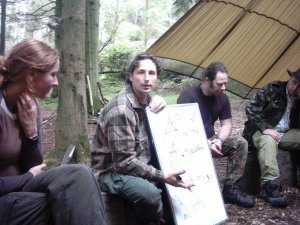 |
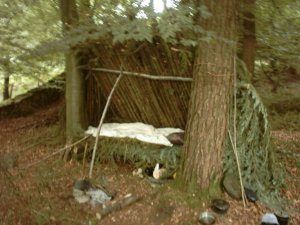 |
A classic Scandinavian lean-to shelter, with a raised bed.
This one was constructed by Dave Alty. Dave and I were on the Abo course together, its always great to see him. |
| A chap on the course called Phil, had asked to build the most sophisticated shelter that woodsmoke could think off.
This shelter used a kind of hook at the top, and a v shaped fork at the bottom, so it sort of hangs of the tree.
Its main features are that its raised of the ground, and can be moved around the tree to stay in the shade.
Not so much a shelter, as a feat of engineering, I was totally impressed. |
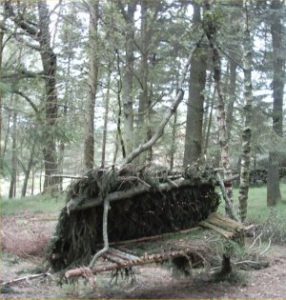 |
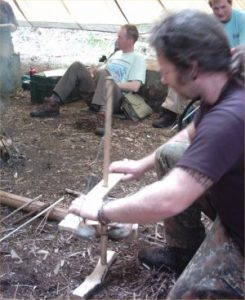 |
The course was designed as a kind of woodlander part 2, and covered advanced techniques of just about every major skill.
Here Rob demonstrates a pump drill, originally designed for drilling holes.
It was the easiest way to make fire from friction that I have ever seen. They had 3 different types to demonstrate. |
| We spent a lot of time working on the fire drill.
As Ben put it, its quite the most elegant way to light a fire.
It required a lot of concentration to get it working. Here Jeremy attempts to get an ember. |
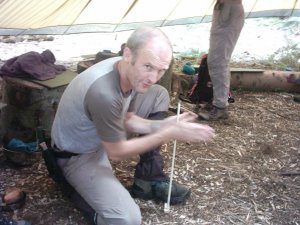 |
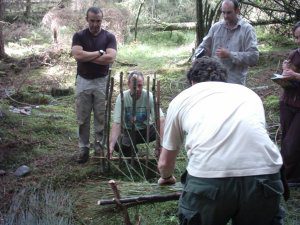 |
We were taught to construct a reed loom. |
| It would enable is to make reed mattresses, which could also be used for “drop-down” shelter doors. |
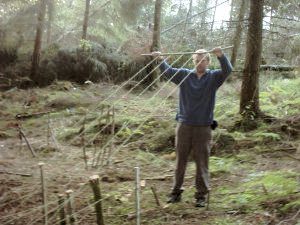 |
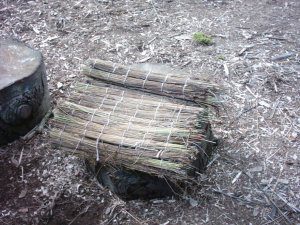 |
The finished mat.
I wish I had known how to make one of these on the abo course.
It was an amazing piece of primitive technology, and would enable a full nights sleep, which would transform the overall bushcraft experience. |
| Lisa teaches us to construct containers from Bark.
She had previously been on a course in Utah, where you had to survive for 10 days, without any man made products. |
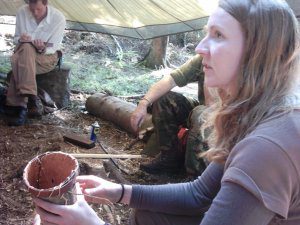 |
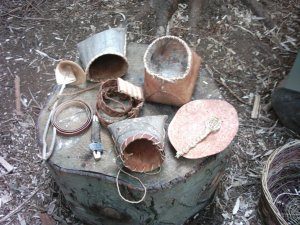 |
A selection of the things that Lisa had previously constructed from Bark, including a belt and knife pouch. |
| I constructed a container for carrying berry’s and stuff like that.
For some reason, I have an expression like a child in this picture, and I am not sure why. |
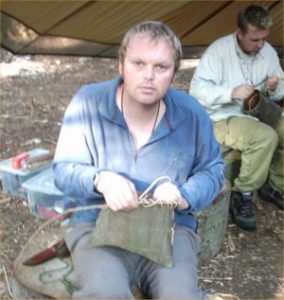 |
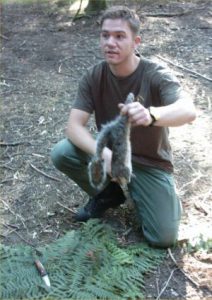 |
I had prepared many different types of animal before, but this was the first time I had cooked Squirrel (in fact, the whole course was full of things I had never done before.)
Preparing animals for cooking, is perhaps the least desirable parts of bushcraft (although actually one of the most important.)
Anthony always teaches it with such enthusiasm and professionalism, that it doesn’t seem so bad. |
| One of the lads, loses his Knife, and ends up looking for it in a bag of guts and offal.
Adds a whole new angle, on taking care of your knife, as it resulted in him being shoulder deep, and later finding that the knife was somewhere else completely ! |
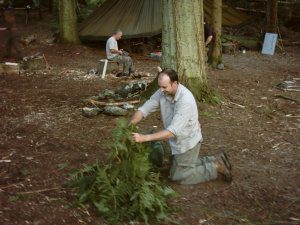 |
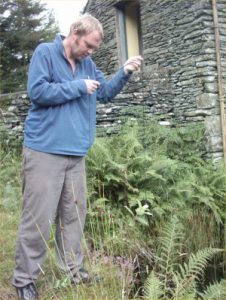 |
We put out some night lines, and I caught a fish.
Pete took a picture of me retrieving it from the water
Since Pete hadn’t used a digital camera before, he didn’t actually get the fish in the picture
You will just have to trust me, I did catch one. |
| The group collect around the boat house.
In the centre of the picture, are the fish that we all caught.
There were some brilliant personalities on this course. |
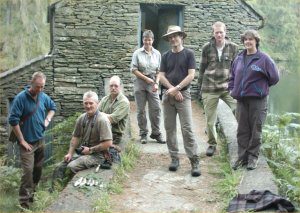 |
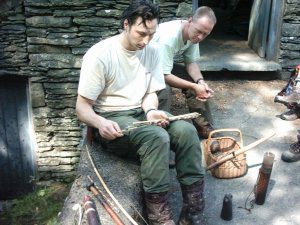 |
Ben gives a general interest talk on hunting and fishing.
He shows us a small bow and arrow, used by African bushmen.
Next to the bow, is a blow pipe and darts, which were amazingly accurate.
There was also, a traditional crossbow, but this isn’t in the picture. |
| I have made an otter board before, but this is one made by a craftsman (Ben).
It features 4 special holes, so a toggle holds the fishing lines in place.
It also had a stone underneath, to keep it upright, and a sail made from a piece of bark. |
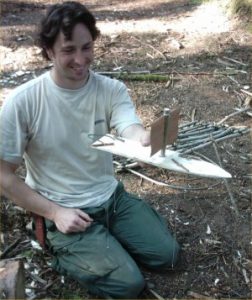 |
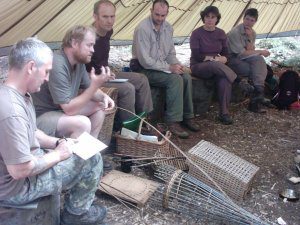 |
A whole day of the course was devoted to basket work, and featured guest instructor, Phil Bradley (Phil is the one speaking passionately about basket making). |
| One of the good things at Woodsmoke, is that there is always boiling water for a brew.
Here Lisa stops for a quick brew.
In front of her, are a selection of the baskets that Phil had previously made. |
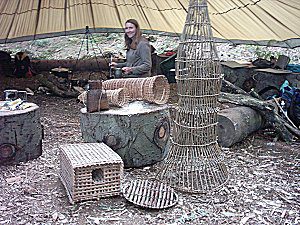 |
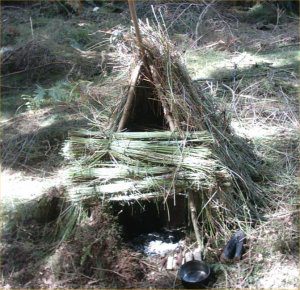 |
Another lad on the course called Phil, made this fish smoker.
The fish that came out of it, tasted delicious. |
| A Roycroft pack frame. The design is brilliantly simple.
The one on the right, was made by Lisa in Utah. |
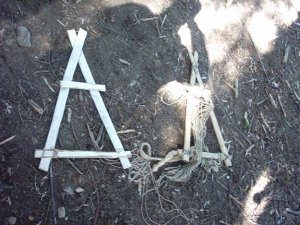 |
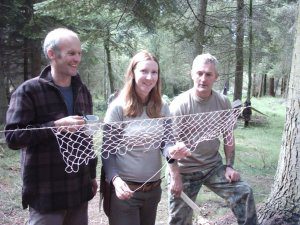 |
Lisa show Jeremy, Pete and me about making nets.
Obviously nets can be used to catch fish, but they also compliment the Roycroft pack frame, to make a functional rucksack. |
| Making a gypsy well.
Unfortunately, this one didn’t work, and as Ben pointed out, there is no perfect formula, you just dig a few of them, and wait until one fills up with water. |
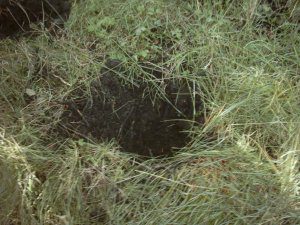 |
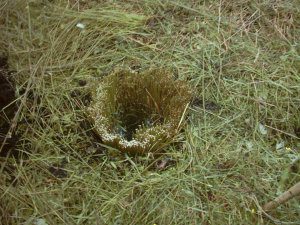 |
This one worked, and had reeds around the outside, so the water was cleaner.
A lot of the self help books I have read, encourage you to think like a child.
The idea, is that when you are young, you have dreams, and that as you get older, people encourage you to be “realistic” and in actual fact kill your enthusiasm.
When I was at school, I remember a teacher talking down to me, and telling me “I bet you are one of those people who think you can get water just be digging a hole in the ground” !.
Mr Evans, from 1st year science at Moston Brook, back at you pal !. |
| Ben demonstrates rock boiling, in one of the Swedish Doe bowls, constructed on the Axe workshop.
Note the Y shaped sticks used to put the rocks into the bowl. |
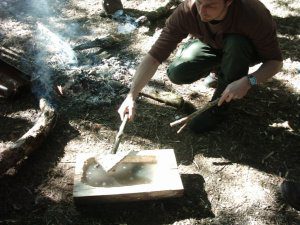 |
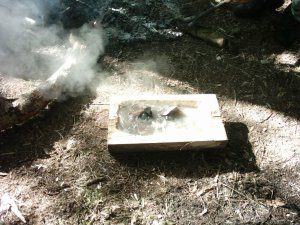 |
The water is fully boiled, and is safe to drink.
Dirt from the stones, however, makes the water a bit grey. |
| Something I had read about many times, but never seen in real life
A box is constructed from bark and held together with small wooden pegs.
As long as the flame doesn’t go higher than the water, the bark container will not catch fire, and the water will boil. |
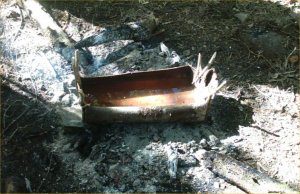 |
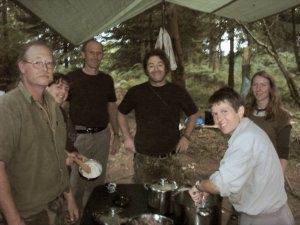 |
Apart from Jamie Oliver, I don’t know anybody that looks this happy in a kitchen !. |